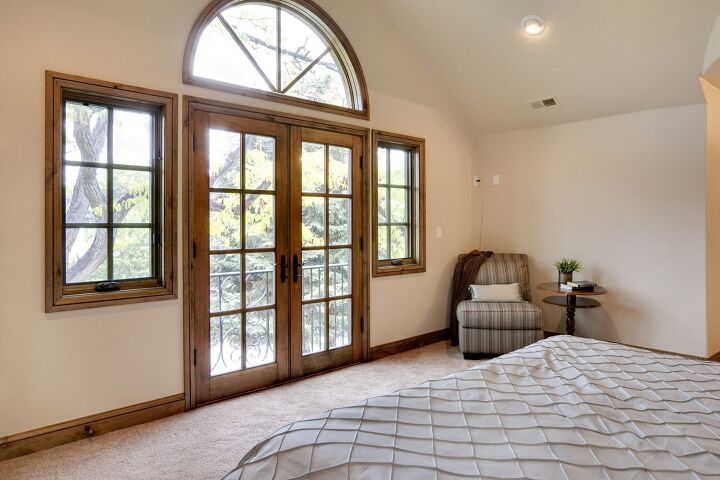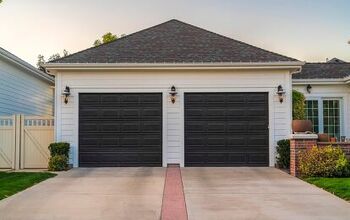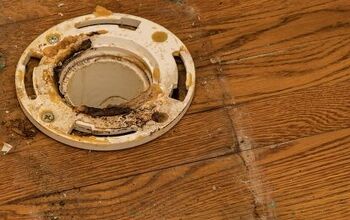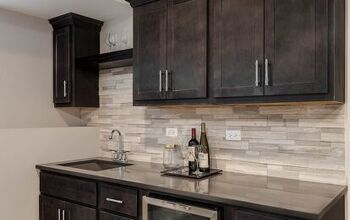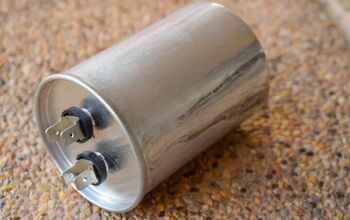Standard French Door Dimensions (with Pictures)

French doors give a classic look to a backyard patio or sunroom or a charming access point to a veranda. They have an instantly recognizable appearance, with their glass doors divided into several panels, called lites. These panels are created with a grid-like framing that goes over the glass, making them look like large windows.
French doors don’t have one standard size but instead, come in widths typically ranging from 30 inches to 72 inches. The most common overall width of a pair of French doors is 72 inches, consisting of two 36-inch doors. The standard height of a French door is 80 inches (79.5 rounded up to 80).
French doors also come in a variety of other widths and heights. Additionally, if you have a larger opening, you can make up the difference with options like sidelights. Proper French doors usually feature two working doors, but sets featuring one fixed door are also common.
What Are the Typical Dimensions of French Doors?
The most common set of French doors is 80 inches tall with an overall width of 6 feet. However, individual doors can vary in width, with the most common sizes between 30 and 72 inches wide.
Typically, you will find French doors that go up in size in two or four-inch increments. For example, a manufacturer might have doors available in 20, 24, 28, 30, 32, 36, 42, 44, and 48-inch widths. Most companies only sell new French doors in pairs, but you can often find singles at restores and similar locations.
What Are the Basic Parts of a French Door?
The basic parts of a French door are the stiles, rails, muntins, glass panels, or lites. A French door can either be one large piece of glass or separate glass panels.
When using individual glass panels, or lites, vertical and horizontal wood strips separate the panels. These strips are called muntins.
The stiles are the sides of the door on either side of the glass, and the rails are the top and bottom. The top and bottom rails and the stiles form the basic frame for the muntins.
For more efficient doors and easier installation, many people use fake muntins. This is a one-piece grid that goes on top of one panel of glass. Going this route also enables you to remove the grid if you decide you want a more modern look.
Whether using individual glass panels or one large piece, people still refer to a French door by the number of lites. So, if fake muntins separate one large glass panel into 15 rectangles, people still call it a 15-lite door.
When to Use French Doors
French doors are a good option if you want to create a wide opening onto a patio or balcony. Both doors open fully with no center post, giving you a clear entry and exit point and an unobstructed view.
French doors are also a good option for separating spaces inside but still maintaining a sense of light and openness. They’re also a great option if you prefer a timeless, classic style or have a more traditional space.
Plus, French doors are an equally good match for farmhouse, cottage, shabby chic, French country, Victorian, and rustic designs. (Just to name a few.)
Advantages of French Doors
French doors feature many advantages over other door options. Here are some primary benefits of using French doors:
- They allow in lots of natural light, opening up a space and keeping it airy and bright.
- French doors are an aesthetically pleasing way to blend the outdoors with the indoors.
- They come in a variety of sizes and materials, making them easy to work into countless design schemes and openings.
- French doors provide an extra-wide opening, offering excellent ventilation.
- The wide opening also creates the illusion of more space as it extends your living space to the outside.
Disadvantages of French Doors
Of course, everything with advantages is bound to have some downsides too. However, if you like the look of French doors, the disadvantages are minimal.
- French doors don’t offer as much privacy as traditional doors. However, you can always combat this with curtains if necessary. There are also special coverings designed for glass doors.
- You need to ensure the wall framing is correct. Special guidelines need to be in place to allow the doors to open and close freely with no center post.
Exterior French Doors
You commonly find French doors in an exterior application, leading to a deck, patio, or balcony. The standard is a set of double doors that lead directly outside. Exterior French doors are usually 30 or 36 inches or larger.
Classic Double French Door
These double French doors are classic, with two functioning doors and no sidelights. You can use sidelights and transoms for a more custom look or to fit a standard pair of doors into a larger opening.
French Doors with Sidelights
You can purchase sidelights in many different sizes. The design typically matches the design of the doors available from the manufacturer. However, you can also request custom designs and sizes as well.
The most common widths of sidelights are 6 inches, 12 inches, and 18 inches. However, some sidelights can be wider, matching the width of a door.
For example, a set of 30-inch double French doors with matching 30-inch sidelights would measure 10 feet overall. If using a more common sidelight size, like 18 inches, with the doors, the overall width would be 8 feet.
Sidelights are a great way to fit French doors into a larger opening and still allow lots of light. For example, say you have a set of three-panel glass sliding doors leading onto your patio. The doors have an overall width of 8-feet, which is larger than a typical set of French doors.
You replace the sliding doors with a standard set of 36-inch French doors, equalling 6-feet. To make up the difference, you install a 12-inch sidelight on each side of the French doors.
French Doors with Transoms
Similar to filling extra space on the sides, what if you have a taller opening than standard 80-inch doors? In this case, you can use transoms, which are windows that go above a doorway. Transom windows don’t have standard sizes.
You can get them in pretty much any size as you can have them custom-made. However, the most common sizes are 20 to 72 inches wide and 6 to 15 inches tall.
Of course, for both transoms and sidelights, you can use them for fit or simply for looks.
Single-Functioning French Door
Another popular style of French doors is actually not actual double doors. Instead, it is one fixed door and one that opens and closes, giving the same look as French doors. The overall sizes of single doors are pretty much the same as double doors.
In this example, each door is 30 inches wide and 80 inches tall. Including the frame, the pair measures 63 inches across and 81.75 inches tall. The entire unit requires an opening of 63.5 inches wide and 82.25 inches tall.
Interior French Doors
Many people also choose to use French doors inside their homes. They’re a great way to separate a space but still not close it off completely. You can find interior French doors in similar sizes as exterior doors, with many more options for smaller doors.
Popular sizes for interior French doors are 18 inches up to 42 inches. Two 18-inch French doors would fit in a regular 36-inch doorway. Here’s a quick breakdown of the overall widths of interior French doors.
| French Door Size | Overall Width of Pair of French Doors |
| 18” | 36” |
| 24” | 48” |
| 28” | 56” |
| 30” | 60” |
| 32” | 64” |
| 36” | 72” |
| 42” | 84” |
The standard height for interior French doors is 80 inches, and you can also get them 82 and 96 inches tall.
Sliding French-Style Doors
Although not technically French doors since they don’t open on hinges, you can get sliding doors that look like French doors. This particular set of 9-lite doors is 84 inches tall and 56 inches wide. They are pocket-style sliding doors, meaning they slide into the wall.
Single French Door
Although you typically can’t purchase just one French door, many interior doors look like a French door. They allow in light and can help blend two spaces together while still offering some separation. These doors are the same size as regular interior doors, measuring 80 inches tall.
You can also get them in 84 and 96-inch heights. The following solid French door on Amazon comes in 18, 24, 28, 32, 36, and 42-inch widths.
Determining the Rough-In Opening for French Doors
When determining the size of your rough opening for a set of double French doors, you need each door’s measurements. For the width of the rough opening, take the door’s width, multiply by two, and add two inches.
So, if you have a 36-inch door, your rough opening needs to be 74 inches wide. For the height, add 2.5 inches to the door’s height. Therefore for a standard 80-inch door, the rough opening would need to be 82.5 inches.
Related Questions
Can you create the illusion of a French door?
If you want the look of a French door but the privacy of a solid door, you can fake it. Take a regular, solid door and adhere a mirrored panel to the front. Then, use trim pieces to frame out the mirror and create the grid pattern on the front.
How much do French doors cost?
A set of French doors can cost anywhere from $350 to over $4,500. The final price relies on many factors, including size, style, amount of lites, real or fake muntins, and more. Installation needs are also a significant consideration.If you’re replacing an existing set of doors with the same size doors, then installation won’t cost very much. Conversely, if you’re installing a new set of French doors into a blank wall, you’re looking at a higher price. Other things that influence the price are adding sidelights, transoms, and any other special features.

Stacy Randall is a wife, mother, and freelance writer from NOLA that has always had a love for DIY projects, home organization, and making spaces beautiful. Together with her husband, she has been spending the last several years lovingly renovating her grandparent's former home, making it their own and learning a lot about life along the way.
More by Stacy Randall




